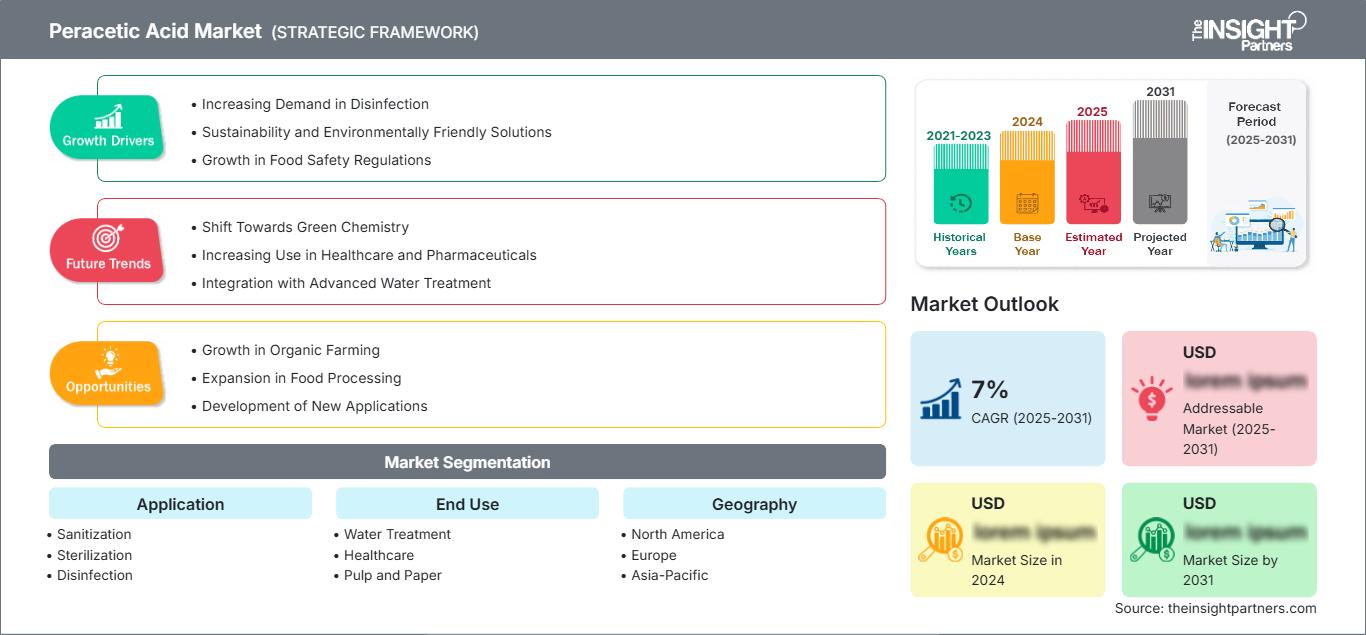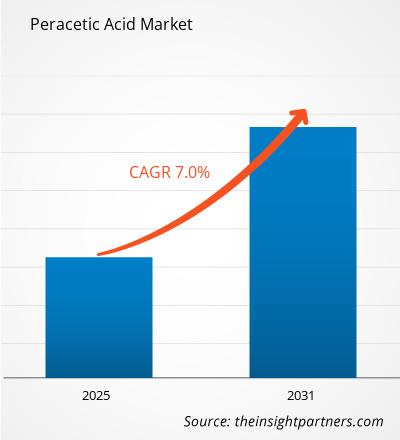Der Markt für Peressigsäure wird voraussichtlich zwischen 2025 und 2031 eine durchschnittliche jährliche Wachstumsrate (CAGR) von 7 % verzeichnen, wobei sich das Marktvolumen von XX Millionen US-Dollar im Jahr 2024 auf XX Millionen US-Dollar im Jahr 2031 ausweitet.
Der Bericht zum Peressigsäure-Markt ist nach Anwendung segmentiert (Desinfektion, Sterilisation, Desinfektion und andere). Die Marktsegmentierung basiert auf der Endnutzung (Wasseraufbereitung, Gesundheitswesen, Zellstoff und Papier, chemische Zwischenprodukte, Lebensmittel und Getränke, Viehzucht und Aquakultur und andere). Der Umfang umfasst die Marktgröße und -prognose auf globaler, regionaler und Länderebene für alle wichtigen Marktsegmente. Der Bericht bietet den Wert in USD für die oben genannte Analyse, Segmente, Regionen und Länder. Der Bericht behandelt Markttrends sowie Marktdynamiken wie Treiber, Einschränkungen und wichtige Chancen. Der Bericht umfasst außerdem eine Branchenlandschaft und Wettbewerbsanalysen, darunter Marktkonzentration, Heatmap-Analyse, prominente Akteure und aktuelle Entwicklungen auf dem Markt.
Zweck des Berichts
Der Bericht „Peressigsäure-Markt“ von The Insight Partners beschreibt die aktuelle Landschaft und das zukünftige Wachstum sowie die wichtigsten treibenden Faktoren, Herausforderungen und Chancen. Dadurch werden Einblicke für verschiedene Geschäftsinteressenten bereitgestellt, wie z. B.:
- Technologieanbieter/-hersteller: Um die sich entwickelnde Marktdynamik zu verstehen und die potenziellen Wachstumschancen zu erkennen, damit sie fundierte strategische Entscheidungen treffen können.
- Investoren: Um eine umfassende Trendanalyse hinsichtlich der Marktwachstumsrate, der finanziellen Marktprognosen und der Chancen entlang der Wertschöpfungskette durchzuführen.
- Regulierungsbehörden: Um Richtlinien und Überwachungsaktivitäten auf dem Markt zu regulieren, mit dem Ziel, Missbrauch zu minimieren, das Vertrauen der Investoren zu wahren und die Integrität und Stabilität des Marktes aufrechtzuerhalten.
Marktsegmentierung für Peressigsäure - Anwendung
- Desinfektion
- Sterilisation
- Desinfektion
Endanwendung
- Wasseraufbereitung
- Gesundheitswesen
- Zellstoff und Papier
- Chemische Zwischenprodukte
- Lebensmittel und Getränke
- Viehzucht und Aquakultur
Sie erhalten kostenlos Anpassungen an jedem Bericht, einschließlich Teilen dieses Berichts oder einer Analyse auf Länderebene, eines Excel-Datenpakets sowie tolle Angebote und Rabatte für Start-ups und Universitäten.
Markt für Peressigsäure: Strategische Einblicke

- Holen Sie sich die wichtigsten Markttrends aus diesem Bericht.Dieses KOSTENLOSE Beispiel umfasst Datenanalysen, die von Markttrends bis hin zu Schätzungen und Prognosen reichen.
Wachstumstreiber für Peressigsäure
- Steigende Nachfrage nach Desinfektionsmitteln: Der steigende Bedarf an wirksamer Desinfektion, insbesondere in der Lebensmittel- und Getränkeindustrie, im Gesundheitswesen und in der Wasseraufbereitung, treibt den Markt für Peressigsäure an. Ihre starken antimikrobiellen Eigenschaften machen sie zur idealen Wahl für die Desinfektion und steigern ihre Nachfrage in Branchen mit strengen Hygienestandards.
- Nachhaltigkeit und umweltfreundliche Lösungen: Peressigsäure gewinnt als umweltfreundliche Alternative zu herkömmlichen Desinfektionsmitteln an Bedeutung, da sie sich rückstandslos in Essigsäure und Sauerstoff zersetzt. Dieses umweltfreundliche Profil treibt die Nachfrage in Branchen an, die Wert auf die Reduzierung der Umweltbelastung legen, wie Landwirtschaft, Lebensmittelverarbeitung und Wasseraufbereitung.
- Verschärfte Vorschriften zur Lebensmittelsicherheit: Strengere Vorschriften zur Lebensmittelsicherheit treiben die Nachfrage nach Peressigsäure an, insbesondere zur Desinfektion von Oberflächen und Verarbeitungsgeräten, die mit Lebensmitteln in Berührung kommen. Ihre Wirksamkeit gegen ein breites Spektrum von Krankheitserregern und ihre Fähigkeit, Hygienestandards in der Lebensmittelproduktion einzuhalten, fördern ihre Akzeptanz in der Lebensmittelindustrie.
Zukünftige Trends auf dem Peressigsäure-Markt
- Wechsel hin zu grüner Chemie: Der Trend zur grünen Chemie beeinflusst den Peressigsäure-Markt, da diese aus natürlichen Substanzen wie Wasserstoffperoxid und Essigsäure hergestellt wird. Dies entspricht der Nachfrage nach sichereren, nachhaltigen Alternativen in Branchen wie der Lebensmittelverarbeitung, Landwirtschaft und Wasseraufbereitung.
- Zunehmende Verwendung im Gesundheitswesen und in der Pharmaindustrie: Peressigsäure wird im Gesundheitswesen und in der Pharmaindustrie zunehmend zur Sterilisation und Oberflächendesinfektion eingesetzt. Angesichts des zunehmenden Fokus auf die Infektionskontrolle in Krankenhäusern, Kliniken und Laboren ist ihre Rolle bei der Einhaltung strenger Hygienestandards in medizinischen Umgebungen ein wichtiger Trend.
- Integration in die fortschrittliche Wasseraufbereitung: Peressigsäure erfreut sich in der Wasseraufbereitung zunehmender Beliebtheit, insbesondere bei der kommunalen und industriellen Wasserdesinfektion. Ihre Fähigkeit, organische Schadstoffe abzubauen und Krankheitserreger effizient abzutöten, macht sie zur bevorzugten Wahl zur Verbesserung der Wasserqualität und trägt zum wachsenden Trend zu fortschrittlichen, umweltfreundlichen Wasseraufbereitungstechnologien bei.
Marktchancen für Peressigsäure
- Wachstum im ökologischen Landbau: Der Aufstieg des ökologischen Landbaus und der Bedarf an natürlichen Schädlingsbekämpfungsmethoden bieten eine Chance für Peressigsäure. Als umweltfreundliche Lösung zur Desinfektion von Nutzpflanzen und zur Kontrolle des mikrobiellen Wachstums bietet Peressigsäure Biobauern eine praktikable Alternative zu chemischen Pestiziden und Fungiziden.
- Expansion in der Lebensmittelverarbeitung: Die Wirksamkeit von Peressigsäure bei der Kontrolle mikrobieller Kontamination bietet bedeutende Chancen in der wachsenden Lebensmittelverarbeitungsindustrie. Mit der steigenden Nachfrage der Verbraucher nach sicheren und biologischen Lebensmitteln kann Peressigsäure zur Verbesserung der Lebensmittelsicherheit und -qualität in den Bereichen Fleisch, Milchprodukte und Frischwaren eingesetzt werden.
- Entwicklung neuer Anwendungen: Es gibt Möglichkeiten, den Einsatz von Peressigsäure in aufstrebenden Sektoren wie der biologischen Sanierung und der Abwasserbehandlung auszuweiten. Da die Nachfrage nach effizienten Umweltlösungen steigt, bietet die Fähigkeit der Peressigsäure, organische Abfälle zu behandeln und Schadstoffe zu zersetzen, ungenutztes Potenzial in der Umwelt- und Abfallwirtschaftsbranche.
Markt für Peressigsäure
Die Analysten von The Insight Partners haben die regionalen Trends und Faktoren, die den Peressigsäuremarkt im Prognosezeitraum beeinflussen, ausführlich erläutert. In diesem Abschnitt werden auch die Marktsegmente und die geografische Lage in Nordamerika, Europa, Asien-Pazifik, dem Nahen Osten und Afrika sowie Süd- und Mittelamerika erörtert.Umfang des Marktberichts über Peressigsäure
| Berichtsattribut | Einzelheiten |
|---|---|
| Marktgröße in 2024 | US$ XX million |
| Marktgröße nach 2031 | US$ XX Million |
| Globale CAGR (2025 - 2031) | 7% |
| Historische Daten | 2021-2023 |
| Prognosezeitraum | 2025-2031 |
| Abgedeckte Segmente |
By Anwendung
|
| Abgedeckte Regionen und Länder | Nordamerika
|
| Marktführer und wichtige Unternehmensprofile |
|
Dichte der Marktteilnehmer für Peressigsäure: Verständnis ihrer Auswirkungen auf die Geschäftsdynamik
Der Markt für Peressigsäure wächst rasant. Die steigende Nachfrage der Endverbraucher ist auf Faktoren wie veränderte Verbraucherpräferenzen, technologische Fortschritte und ein stärkeres Bewusstsein für die Produktvorteile zurückzuführen. Mit der steigenden Nachfrage erweitern Unternehmen ihr Angebot, entwickeln Innovationen, um den Bedürfnissen der Verbraucher gerecht zu werden, und nutzen neue Trends, was das Marktwachstum weiter ankurbelt.

- Holen Sie sich die Markt für Peressigsäure Übersicht der wichtigsten Akteure
Wichtige Verkaufsargumente
- Umfassende Abdeckung: Der Bericht analysiert umfassend Produkte, Dienstleistungen, Typen und Endnutzer des Peressigsäuremarktes und bietet einen ganzheitlichen Überblick.
- Expertenanalyse: Der Bericht basiert auf dem umfassenden Verständnis von Branchenexperten und Analysten.
- Aktuelle Informationen: Der Bericht gewährleistet Geschäftsrelevanz durch die Berichterstattung über aktuelle Informationen und Datentrends.
- Anpassungsoptionen: Dieser Bericht kann an spezifische Kundenanforderungen angepasst werden und passt sich optimal an die Geschäftsstrategien an.
Der Forschungsbericht zum Peressigsäuremarkt kann daher dazu beitragen, die Branchensituation und die Wachstumsaussichten zu entschlüsseln und zu verstehen. Obwohl es einige berechtigte Bedenken geben mag, überwiegen die Vorteile dieses Berichts tendenziell die Nachteile.
- Historische Analyse (2 Jahre), Basisjahr, Prognose (7 Jahre) mit CAGR
- PEST- und SWOT-Analyse
- Marktgröße Wert/Volumen – Global, Regional, Land
- Branchen- und Wettbewerbslandschaft
- Excel-Datensatz
Aktuelle Berichte
Verwandte Berichte
Erfahrungsberichte
Grund zum Kauf
- Fundierte Entscheidungsfindung
- Marktdynamik verstehen
- Wettbewerbsanalyse
- Kundeneinblicke
- Marktprognosen
- Risikominimierung
- Strategische Planung
- Investitionsbegründung
- Identifizierung neuer Märkte
- Verbesserung von Marketingstrategien
- Steigerung der Betriebseffizienz
- Anpassung an regulatorische Trends




















 Kostenlose Probe anfordern für - Markt für Peressigsäure
Kostenlose Probe anfordern für - Markt für Peressigsäure